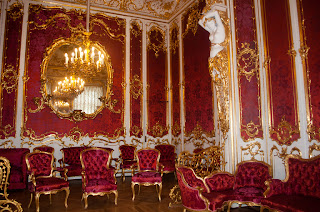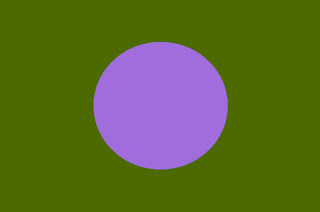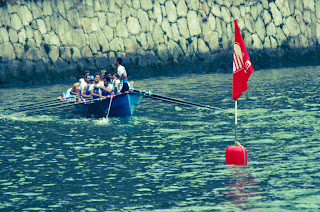There are four groups which illustrate the colour relationships:
- Colour harmony through complementary colours.
 |
| Camera body: Nikon d90 Lens: Nikkor 70-300 mm f/4,0-5,6 f/11 1/350 s ISO 640 Focal length: 135 mm |
This is the Prague Astronomical clock. The Medieval "orloj" dates from the 15th century and It's the most popular tourist attraction in Prague. Every hour there's a show on it: the procession of the Twelve Apostles and it also has a ring with the sings of the zodiac.
I found it odd and I took some pictures. When I processed this image I really liked it because of the colour and the mystic sense that causes on me.
 |
| colour sketch |
If we analyze the picture by its colours, we have three main colours in it: blue, orange and yellow. So we have a colour harmony through complementary colours (blue/orange) and both colours achieve the ideal proportion between them (1:2).
 |
Camera body: Nikon d90 Lens: Nikkor 18-55 mm f/3,5-5,6 f/11 1/180 s ISO 200 Focal length: 55 mm |
I've also chosen colour harmony through blue/orange for the second image. But this time I prepared a still life at home. I took this colourful toucan and set a black background. The difference between the picture above are that saturation is higher this time and here I didn't follow the ideal proportions theory because what I was following in this picture was vivid colours. To get those vivid colours and increase saturation, I underexposed the photograph a little. Maybe some people can tell that it's dark but I like as it is and I'm very happy with the result.
I've started to like the studio photography and still life so I tried another shot for this Assigment but this time, I changed the colours and chose red and green to get the colour harmony.
 |
Camera body: Nikon d90 Lens: Nikkor 70-300 mm f/4,0-5,6 f/16 1/90 s ISO 200 Focal length: 190 mm |
 |
| Colour sketch |
Here, I set a red background and I used my ipod and the Heineken mini couch as my green subjects. At first they were the only subjects and my intention was leaving space in the right side and putting the ipod on the couch but looking at the view I guessed that the idea wasn't going to work; the image wouldn't be balanced. So I decided to fill the right side supporting the ipod on the couch and create a relationship between the two subjects.
Then I had another problem: the ipod couldn't be supported as it's shown in the picture so I had to add another element in the back. I found a red canddle so I used it and it helped the image to have some depth. Finally I found the couch very simple and I added the cherry tomatoes trying to balance the image.
In my opinion I was succesfull in getting a harmonious picture through red and green colours.
Altough there is no specified that we have to used all the complementary colours for the Assigment I wanted to get a photograph balanced by purple and yellow colours. I knew that it's the most difficult colour combination and I wanted to be original in the election of the subject. I didn't want to shoot flowers because they are the usual subjects in most purple/yellow combinations. And I got it:
 |
Camera body: Nikon d90 Lens: Nikkor 70-300 mm f/4,0-5,6 f/4,0 1/250 s ISO 1600 Focal length: 70 mm Camera on tripod. |
 |
| Colour sketch |
I have adjusted the contrast in Lightroom to give more drama to the image. The photograph was taken in a rowing champioship. The light was not enough to freeze the ships movement so I had to set a high ISO such as 1600. I prefered noise than blurry movement because my goal was to shoot colour combination not speed.
I tried to keep the ideal proportion of 1:3 in the image but I guess that the yellow boat should be in the background and the purple one in the foreground and I should crop a little more the yellow boat. But anyway, both colours work well together in the picture and the greenish water adds drama to the competition.
The picture would improve if it were sharper. This is because I had to use an aperture such as f/4,0 because I wanted to increase my shutter speed as much as possible to freeze movement but I had to open the aperture and this affected to DOF. And after having examined the framing, I also have to tell that placing the boats in diagonal would have given more drama and dinamism to the image.
2. Colour harmony through similar colours.
The colours near each other on the colour wheel or in a cool or warm range of colours help to get colour harmony, so let's explore them.
 |
Camera body: Nikon d90 Lens: Nikkor 18-55 mm f/3,5-5,6 f/4,0 1/60 s ISO 1600 Focal length: 18 mm |
It's a glass building in London. I got very close to it and shooted inside giving an abstract sense to the image. The green and blue combination reminds me to a sci-fi film scene. The colours combine properly to give an unnatural aspect to the picture, which is what I intended to show.
 |
Camera body: Nikon d90 Lens: Nikkor 18-55 mm f/3,5-5,6 f/5,6 1/3000 s ISO 800 Focal length: 52 mm |
 |
| colour sketch |
I went to a wine festival in Prague and while I was walking around the vineyards I saw the sign. I loved the red leaves around it and I started to imagine about adjusting the colour of the sky to make it purple and show as a reference to red wine.
I changed the blue sky for the purple one in Lightroom. I wanted to make it as wine colour but I also wanted to be realistic, so I didn't want to manipulate the image too much. And yes, maniulation is evident but I also have seen this colour in the sky in the summer so I decided it was acceptable like that.
This shows my "wine glass" experience in Prague using purple and red colour to balance the harmony in the picture.
 |
Camera body: Nikon d90 Lens: Nikkor 18-55 mm f/3,5-5,6 udiof/4,8 1/60 s ISO 800 Focal length: 18 mm Flash used. |
Here I have used the warm range of colours to create harmony in the picture. Everything is brownish, orangish or yellowish in the image, even the lighting helps to create that sensation altough I used the camera's built in flash.
The image was taken in the Golden Lane in Prague Castle. I don't know exactly what was recreated here but in my opinion this is like a wax or glass working studio and following my supposition, heat and fire were essential while it was operative, so warm colours work pretty well to remind this place's original appearance.
It would be a wonderful background to make an artist or worker portrait. An human figure could make the image more interesting but anyway the photograph captures the attention because there are lots of details and the warm colour range helps to set the atmosphere.
 |
Camera body: Nikon d90 Lens: Tamron 90 mm Macro f/2,8 f/16 1/125 s ISO 200 Flash used. |
After shooting outside I decided it was time to retry a still life so researching on the web, I saw an image of a pear made by other fruit pieces. I took the idea by instead of trying to recreate the shape of the apple I tried to break the idea and made an unrealistic image to finish this part of the Assigment, like the first picture (the blue/green abstract building).
So I cut an apple into two pieces and then added some lemon, orange and tangerine pieces in the middle to get, finally, a fruit hamburguer.
I think the picture works well by its shape but I would remove the tangerine piece in the top and I also would change the dish by another one because the red flower contrasts with the apple and is distracting. In my opinion changing this two thing the picture would improve and colour harmony would be created through similar colours.
3. Colour contrast through contrasting colours.
 |
Camera body: Nikon d90 Lens: Nikkor 18-55 mm f/3,5-5,6 f/3,5 1/60 s ISO 400 Focal length: 18 mm Flash used. |
This is a room located in the Hermitage museum (St. Petersburg, Russia). Like every palace in Russia, it's really astonishing and elegant.
The room is called the Red Room for obvious reasons. The baroque style golden ornaments contrast with the red upholstery in the chairs and walls.
The room is twice wide as it shown in the picture decide to crop the framing because of two reasons: the distortion caused by the wide angle lens and because I liked this pont of view in which I captured the reflection of the lamp and the position of the female statue. There is another reason that is hardly visible: there's a hidden door in the centre of the image!
 |
Camera body: Nikon d90 Lens: Nikkor 18-55 mm f/3,5-5,6 f/11 1/180 s ISO 1000 Focal length: 22 mm |
This is an autumm scene which I like because it's contrast between the orange dead leaves in the foreground, the saturated green in the middle and the different green-orange tones in the background.
The low point of view and the tree in the right side, also give a special environment to the picture. Altough some branches are a little bit distracting, this is one of my favourite pictures in this Assigment, because of the contrasting and vivid colours. I have made the sky to be washed out, without any detail to centre the attention on the dead leaves and the trees in the background.
 |
| colour sketch |
I took this picture in Covent Garden, London from a higher point of view. The smoked yellow paella attracted my attention inmediately and then I saw the woman's blue shirt which contrasted with the paella.
Furthermore, the contrasting red and yellow peppers in the right corner help to add interest to the scene.
 |
Camera body: Nikon d90 Lens: Nikkor 18-55 mm f/3,5-5,6 f/5,6 1/125 s ISO 200 Focal length: 55 mm |
 |
| Colour sketch |
Another contrasting colour combination would be created by green and purple.
I found this flower in the edge of a path. It was the only flower around and this captured my attention. So I decided to place it in the centre of the frame and set a large aperture such as f/4,0 to get a shallow DOF. This would made the background blurry and it would become less distractive, giving all the attention to the flower.
If we examine the image according to Goethe's colour brightness theory, the ideal proportion would be 1:2 because he gave to green a level of 6 and to purple a level of 3. The picture doesn't follow the theory; but placing the purple in the centre the sense of this proportion becomes stronger.
4. Colour accent using any of the above.
 |
Camera body: Nikon d90 Lens: Nikkor 70-300 mm f/4,0-5,6 f/11 1/100 s ISO 400 Focal length: 130 mm |
 |
| colour sketch |
My first attempt to photography a colour accent image was using complementary colours. I found a red little pine among thoushand of green pines and I didn't have any doubt in taking the picture. The scene transmited me the feeling that the little red pine was fighting to survive among its healthy brothers.
What I was trying to communicate with the image is the fire, the fight to survive in nature; so I use the red accent because its amount in the screen is smaller but it gives that strength to the image.
For the next picture I also use red accent but in this case, the background is blue, so it becomes a colour accent picture using contrasting colours.
 |
Camera body: Nikon d90 Lens: Nikkor 7'-300 mm f/4,0-5,6 f/5,6 1/250 s ISO 1600 Focal length: 300 mm |
 |
| colour sketch |
I've applied the old polar preset in Lightroom to this picture because it reminds to tradition. Rowing is a traditional basque sport that unlike most parts in the world, is practiced at sea. Altough today the boats and oars are addapted to the present they haven't changed its original shape and the original confrontation between the different villages is already present, so the blueish preset gives this traditional atosphere to the scene.
But the red flag contrasts with the blue in the picture and adds dinamism, in the sense that it becomes a goal to be reached by the blue boat's crew.
 |
Camera body: Nikon d90 Lens: Nikkor 18-55 mm f/3,5-5,6 f/11 1/125 s ISO 1000 Focal length: 42 mm |
 |
| colour sketch |
I took the picture in a golf club. I loved the quiet sensation caused by the inmense green in font of me. It was quitea windy day but ir's hardly noticed unless you pay attention to the red flag.
So the red accent using complementary colours helps to add some dinamism in a peaceful scenerey. Maybe if I had arrived sometime before the light wold be better and the great tree in the right would be brighter and more impressive but I'm quite happy with the image.
And finally, the last picture in this Assigment.
 |
Camera body: Nikon d90 Lens: Tamron 90 mm Macro f/2,8 f/3,3 1/3 s ISO 400 Tripod used. |
 |
| colour sketch |
Well, here I use two orange spots to act as color accents. At first, my idea was to use this picture for the first group (colour harmony through complementary colours) but I changed my mind and clasified it as colour accent using complementary colours.
The two orange spots creates a relationship between them but also between the rest of the image because of their rounded shape and the attract the attention to the centre circle.
I have sent more pictures which are not included in this Assigment to my tutor. They were some picture I was unsure about them and I discarded in favour of those shown here.


No hay comentarios:
Publicar un comentario